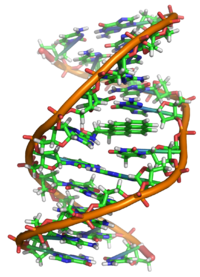Benzo(c)fluorene
It is a component of coal tar, cigarette smoke and smog and thought to be a major contributor to its carcinogenic properties.[1] The mutagenicity of benzo[c]fluorene is mainly attributed to formation of metabolites that are reactive and capable of forming DNA adducts.Benzo[c]fluorene occurs naturally in tar, but can also be manually synthesized in a four step process, which is depicted in the picture below.[1][2] Exposure to benzo[c]fluorene in vivo leads to the induction of mainly lung tumors where it acts as a DNA adductor.The formation of DNA adducts in human breast tumors, hepatoma and colon adenocarcinoma by these metabolites has been shown in vitro.These adducts and the ones that were observed in lung tumors of mice were similar, which strengthens the hypothesis that human cells are capable of forming the mutagenic metabolites.To estimate the health effects that arise from exposure to PAHs and benzo[c]fluorene it is necessary to determine the concentration of these compounds in the atmosphere.They compared the concentrations of different PAHs including benzo[c]fluorene in Beijing and Kanazawa in winter and summer.Only in the TA98 strain plate, which contained a fraction of a rat liver, a higher dose of benzo[c]fluorene seems to correspond with a larger amount of revertants.This and another similar study suggest a contribution of benzo[c]fluorene to the carcinogenic potency of coal tar when administered orally.[1][18] Another study found that benzo[c]fluorene is also carcinogenic in mice when applied topically, inducing lung and skin cancer.This figure shows the DNA adduct level after a certain dose of benzo[c]fluorene was applied to the skin of mice.![7H-Benzo[c]fluorene](http://upload.wikimedia.org/wikipedia/commons/thumb/4/4f/Benzocfluorene.svg/220px-Benzocfluorene.svg.png)




bracketsPreferred IUPAC nameCAS NumberChemSpiderECHA InfoCardEC NumberPubChemCompTox DashboardChemical formulaMolar massDensityMelting pointBoiling pointstandard statepolycyclic aromatic hydrocarbonmutageniccoal tarcarcinogenicDNA adductsfluorenebenzeneDNA adductmetabolitebenzo[a]pyrene1-indanonebrominatedsubstitution reactionN-bromosuccinimidetriethylaminereductionhydrazine hydrateepoxidebiotransformationCYP1A1lipophilicitycell membranefluorantheneglucuronidesulfateglutathionemutationtopicaltumorscombustionendocrineAmes testframeshift mutationspoint mutationstopicallydose-response curvemutagenBenzo[a]fluoreneWayback MachineBibcode